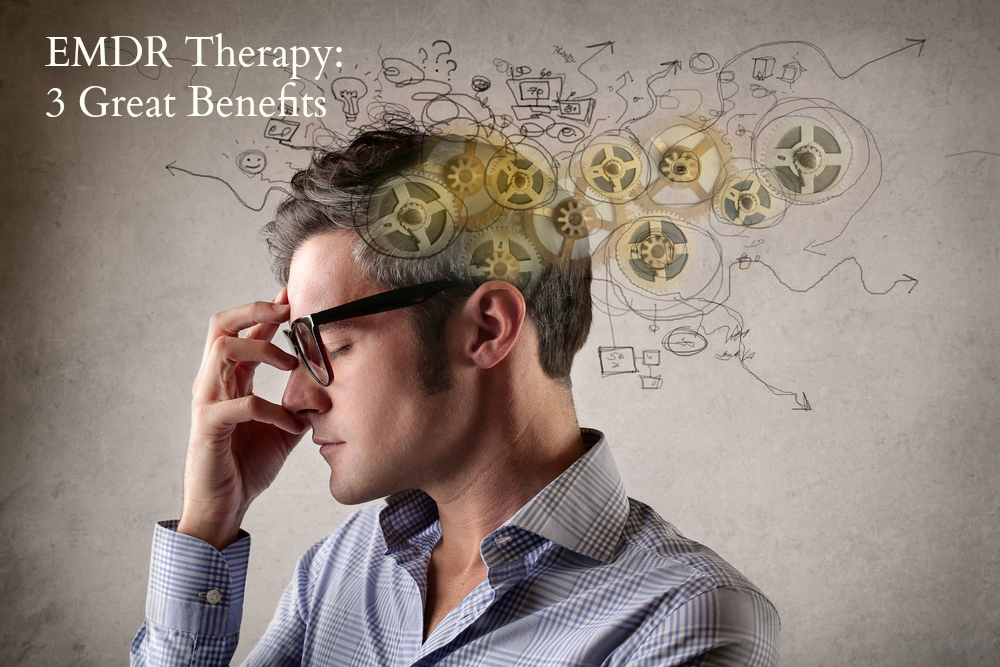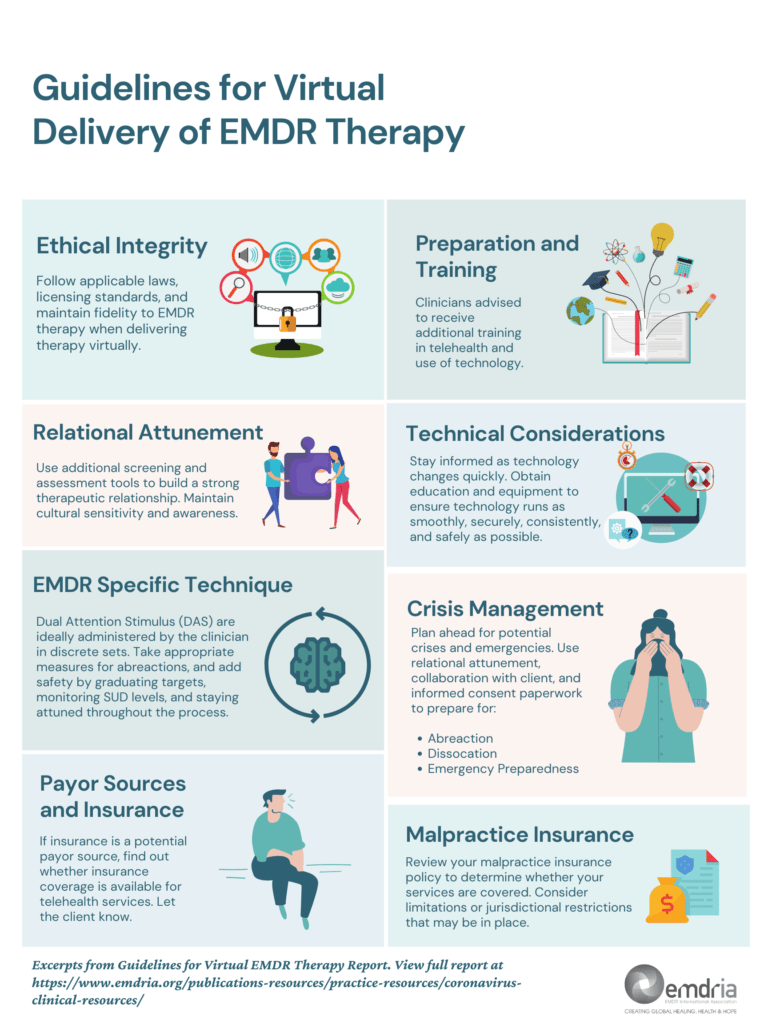Exactly How EMDR Therapy Works: an In-depth Take A Look At the Refine and Its Efficiency
EMDR treatment has become a popular treatment for trauma-related conditions. Its organized approach includes numerous stages created to promote the handling of stressful memories. Central to this technique is the concept of reciprocal stimulation, which plays an essential role in just how memories are refined. Understanding these aspects reveals much about the therapy's effectiveness. Nonetheless, what especially happens throughout an EMDR session, and exactly how does it impact the healing trip?
Understanding the Concepts of EMDR Therapy
EMDR treatment, or Eye Activity Desensitization and Reprocessing, operates the property that unsolved terrible experiences can hinder emotional wellness. This cutting-edge therapeutic approach intends to promote the handling of traumatic memories, enabling people to obtain a much healthier point of view on their past. Central to EMDR is the idea of reciprocal excitement, typically achieved with led eye motions, which is believed to assist incorporate terrible memories right into a more adaptive structure.

The Eight Stages of EMDR Therapy
The process of EMDR therapy unfolds over eight unique stages, each made to assist clients with a structured technique to recovery injury. The initial stage involves history-taking, where the therapist examines the customer's history and determines target memories. In the second phase, customers learn relaxation methods to handle distress. The third stage focuses on determining negative beliefs linked with the traumatic memory.
The fourth stage is where the desensitization process starts, enabling clients to refine the distressing memory. The fifth phase includes installing positive beliefs to replace the negative ones. In the 6th phase, customers are guided to examine their emotional and physical actions to the refined memory. The seventh phase emphasizes closure, helping customers return to a state of balance. Finally, the eighth phase includes reevaluation, where customers and therapists evaluate development and resolve any residual distress. This complete approach cultivates a pathway to healing and durability.
The Role of Reciprocal Excitement
Bilateral stimulation is a necessary part of EMDR treatment, promoting the processing of traumatic memories. This method entails alternating stimulation of both hemispheres of the mind, usually attained via eye activities, auditory tones, or responsive feelings. The purpose of bilateral stimulation is to engage the great post to read brain's all-natural information processing system, which might end up being interrupted adhering to trauma.
By turning on both sides of the brain, reciprocal excitement assists clients gain access to and recycle distressing memories in a much more adaptive method. This technique motivates the combination of terrible experiences, lowering their psychological fee and making it possible for customers to establish new perspectives.

Furthermore, reciprocal stimulation may advertise relaxation and decrease anxiety during sessions, creating a safer setting for clients to challenge excruciating memories. Eventually, this method boosts the therapeutic process, enabling individuals to approach additional hints recovery and resolution.
Proof Sustaining the Effectiveness of EMDR
Research has shown that EMDR therapy works in treating numerous psychological conditions, particularly trauma (PTSD) Many studies have actually shown considerable reductions in PTSD signs and symptoms adhering to EMDR treatment. A meta-analysis of randomized regulated trials found that EMDR was as efficient as cognitive behavioral therapy (CBT) for PTSD, with lasting results observed even months after treatment. In addition, the American Psychological Organization and the Globe Health and wellness Company endorse EMDR as an advised therapy for trauma-related conditions.
Beyond PTSD, research study shows that EMDR can also profit individuals struggling with anxiety, depression, and fears. An expanding body of evidence supports its usage in varied populaces, including youngsters and experts - licensed emdr therapists nyc. On the whole, the gathering research study highlights EMDR's possible as a versatile therapeutic option, leading the way for additional exploration into its systems and applications in mental wellness therapy
What to Expect During an EMDR Session
During an EMDR session, customers can expect a structured yet flexible technique focused on processing stressful memories. The therapist starts by establishing a safe setting, where clients can really feel comfortable sharing their experiences. Initial discussions concentrate on recognizing specific memories and linked negative ideas.
Customers are assisted to focus on these memories while concurrently participating in bilateral stimulation, commonly through led eye activities or tapping. This twin focus aims to assist in the processing of the injury, enabling clients to reframe their experiences and minimize psychological distress.
Throughout the session, therapists keep track of clients' reactions, changing the rate and method as required. Procedure may include relaxation strategies or cognitive restructuring to strengthen favorable ideas. On the whole, customers can prepare for an encouraging environment that urges self-exploration and recovery, ultimately bring about a higher sense of emotional wellness.
Regularly Asked Inquiries
Is EMDR Treatment Suitable for Kid or Adolescents?
EMDR treatment can be ideal for children this link and adolescents, gave it is adjusted to their developmental requirements (emdr therapy new york city). Clinicians often change strategies to ensure safety and security and efficiency, supporting more youthful populaces in processing trauma and psychological distress
For How Long Does EMDR Therapy Normally Last?
EMDR treatment usually lasts in between 8 to 12 sessions, with each session ranging from 60 to 90 mins. Individual demands and the complexity of trauma can affect the general duration of treatment.
Can EMDR Treatment Be Done From Another Location or Online?
EMDR therapy can indeed be performed from another location or online. Many specialists have adapted their techniques to virtual environments, allowing customers to involve in reliable sessions from the comfort of their homes, preserving restorative advantages.
What Are the Possible Adverse Effects of EMDR?
Prospective negative effects of EMDR therapy may include short-lived psychological distress, heightened anxiety, vivid memories, and physical discomfort. Individuals could also experience exhaustion or migraines following sessions, as the mind refines extreme feelings and memories.
Just How Does EMDR Contrast to Standard Talk Therapy?

EMDR therapy, or Eye Motion Desensitization and Reprocessing, operates on the property that unresolved traumatic experiences can prevent emotional well-being. The procedure of EMDR therapy unfolds over 8 unique stages, each developed to assist customers via an organized technique to recovery injury. Bilateral stimulation is a vital element of EMDR therapy, facilitating the handling of distressing memories. During an EMDR session, customers can expect a structured yet flexible strategy intended at processing terrible memories. Potential side effects of EMDR therapy may consist of momentary emotional distress, increased anxiety, vibrant memories, and physical pain.